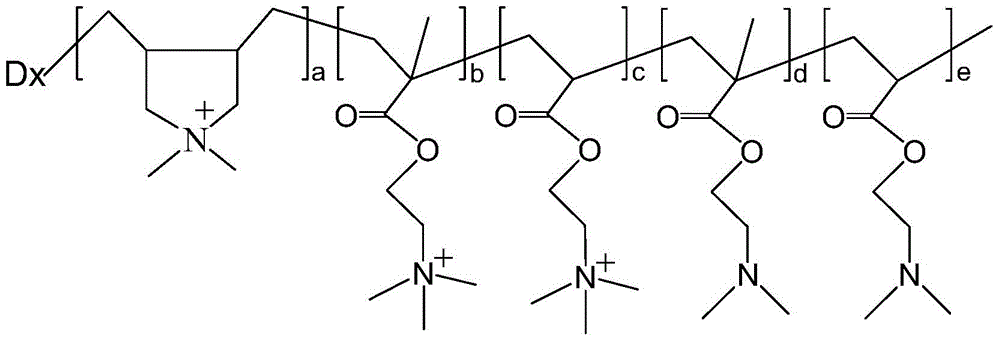A kind of graft copolymerization type cationic polysaccharide biological flocculant and preparation method thereof
A technology of biological flocculant and cationic polysaccharide, applied in the field of graft copolymerization type cationic polysaccharide biological flocculant and its preparation, can solve the problems of inseparability and difficult to compare with adsorption bridging, and achieve high positive charge density and good social The effect of economic benefits and broad market prospects
- Summary
- Abstract
- Description
- Claims
- Application Information
AI Technical Summary
Problems solved by technology
Method used
Image
Examples
Embodiment 1
[0032] Nonionic polysaccharide bioflocculant grafted with methacryloyloxyethyltrimethylammonium chloride and acryloyloxyethyltrimethylammonium chloride.
[0033] In the 500ml there-necked flask, add 200g mass concentration to be the non-ionic polysaccharide biological flocculant (Dx) solution of 15%, start to stir, add the methacryloyloxyethyl trimethyl ammonium chloride ( DMC) solution 50g and mass concentration are 80% acryloyloxyethyltrimethylammonium chloride (DAC) solution 25g, after logical nitrogen deoxygenation, be warming up to 30 ℃, add ammonium persulfate 0.36g, bisulfite Sodium 0.09g, after reacting for 1h, heat up to 60°C and add 0.09g of dibenzoyl peroxide (BPO), continue stirring for 3h, stop nitrogen flow, feed air to terminate the reaction, take it out, the product is precipitated with ethanol, after ethanol and After extraction with water and washing, dry in a vacuum oven at 50°C until constant weight and grind.
[0034] The results show that the monomer con...
Embodiment 2
[0036] Nonionic polysaccharide bioflocculant grafted with dimethylaminoethyl methacrylate and dimethylaminoethyl acrylate.
[0037] Adding 200g mass concentration in a 500ml three-necked flask is a 15% non-ionic polysaccharide bioflocculant (Dx) solution, start stirring, add dimethylaminoethyl methacrylate (DMAEMA) 30g and dimethylaminoethyl acrylate ( DMAEA) 30g, after blowing nitrogen to remove oxygen, heat up to 50°C, then add cerium ammonium nitrate 0.45g, after reacting for 8 hours, stop nitrogen blowing, blow in air to terminate the reaction, take it out, precipitate the product with ethanol, and extract it with ethanol and water , After washing, dry in a vacuum oven at 50°C until constant weight, and grind.
[0038] The results showed that the monomer conversion rate was 69.5%, the cationic degree was 34.6%, and the flocculation effect was good.
Embodiment 3
[0040] Nonionic polysaccharide bioflocculant grafted with methacryloyloxyethyltrimethylammonium chloride.
[0041]In the 500ml there-necked flask, add 200g mass concentration and be 15% non-ionic polysaccharide biological flocculant (Dx) solution, start stirring, add the aqueous solution containing 60g methacryloyloxyethyltrimethylammonium chloride (DMC), After passing nitrogen to remove oxygen, heat up to 40°C, add cerium ammonium nitrate 0.45g, react for 4 hours, stop nitrogen, pass air to terminate the reaction, take it out, the product is precipitated with ethanol, extracted with ethanol and water, and washed at 50 °C in a vacuum drying oven to constant weight and grind.
[0042] The results showed that the monomer conversion rate was 62.7%, the cationic degree was 43.53%, and the flocculation effect was obvious.
PUM
 Login to View More
Login to View More Abstract
Description
Claims
Application Information
 Login to View More
Login to View More - R&D
- Intellectual Property
- Life Sciences
- Materials
- Tech Scout
- Unparalleled Data Quality
- Higher Quality Content
- 60% Fewer Hallucinations
Browse by: Latest US Patents, China's latest patents, Technical Efficacy Thesaurus, Application Domain, Technology Topic, Popular Technical Reports.
© 2025 PatSnap. All rights reserved.Legal|Privacy policy|Modern Slavery Act Transparency Statement|Sitemap|About US| Contact US: help@patsnap.com



